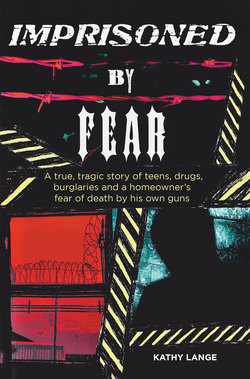Читать книгу Imprisoned by Fear - Kathy Lange - Страница 7
На сайте Литреса книга снята с продажи.
ОглавлениеByron Smith is a retired State Department employee and Vietnam veteran who came back to his hometown of Little Falls, Minnesota, for an early retirement and to take care of his elderly mother. After his mother passed, he wanted to remain in the home his father built, enjoying the solitude of his thirteen acres along the banks of the Mississippi River. For two years, he led a comfortable, quiet life, taking occasional trips out of state to mentor with various Boy Scout troops. On November 22, 2012, Thanksgiving Day, two teens broke into his home by shattering his bedroom window with a metal pipe. It was the sixth time in five months that his home had been burglarized. He shot and killed both teens as they descended his basement stairs. Even though they were in the commission of a felony and guns had been stolen from previous burglaries, he was arrested the next day and charged with second-degree murder. As evidence was gathered, one of the teens involved in previous break-ins was a kid that Byron Smith had wanted to help by teaching and offering him yard work and the opportunity to take him deer hunting. The Morrison County prosecutor’s office labeled his actions as cold-blooded and the local sheriff called him an executioner. Byron Smith, who served his country in the Air Force and continued to work for the United States for another sixteen years, went unsupported by the United States State Department, his own county government, including judge and jury and the sheriff’s department. Was the fear of exposing a multitude of criminal activities from high school students the decision that led the judge to not allow any testimony at trial from them? Was Sheriff Wetzel’s fear of publicly exposing no investigation into Smith’s burglaries the decision that turned Byron Smith into a murderer instead of the victim? After all, was it Byron’s responsibility to “save” the kids instead of himself? Minnesota statute 609.065 states that the taking of a life is justified if that person is in the commission of a felony in one’s abode. Certainly the two intruders on Thanksgiving were there to steal before they attended dinner with their families. Were they stealing for the mere thrill of it or to buy drugs? After all, prescription pill bottles from a previous home invasion were found in Nick Brady’s car. As a nation, the opioid epidemic causes a new set of problems not only medically, but drug-related crimes increase across many communities. How do communities keep everyone safe—the decent, law-abiding homeowner minding his own business and then those addicted and committing crimes? In this case, why was Statute 609.065 completely ignored by the jury?
This story is a personal look at the real Byron Smith, a man without so much as a parking ticket, who stands convicted of murder. This is the other side of the story that the media never wrote or spoke about. It is a story of consequential fear. The fear that led Byron Smith to feel unsafe in his own home for months as he was terrorized by misguided teenage thieves. He had spent great time, energy, and expense on dead bolts and replacing previously damaged locks and security cameras. On Thanksgiving Day, he had locked all windows and doors to deter entry. If he had wanted them to enter, as was the prosecutor’s trap theory, it doesn’t make sense that he wouldn’t have left the doors unlocked to make sure they came in. This is also about community fear. The community’s fear of exposing drug traffic in nice, quiet neighborhoods with little resources or lack of leadership to stop it. It is all these fears—the school, the judge, the sheriff, the community, but most of all, the misunderstood, underexposed fear of Byron Smith. Was Byron Smith’s fear less significant than all the others’ fear? His was a fear that none of us could ever imagine being subject to. How many of us have come into our home finding every drawer and room ransacked, cherished items gone, wondering if and when the invaders will return? They have also stolen your guns. How many of us have felt that we may be killed by our own stolen gun? That fear would be incomprehensible for any of us and certainly not the average juror. Byron’s fear was dismissed, discarded. The deepest fear none of us should ever experience.
